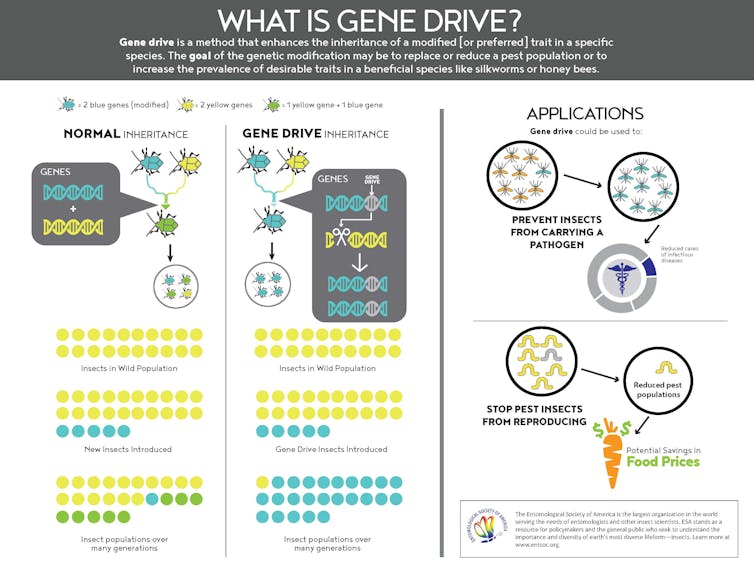The fate of society rests in part on how humans navigate their complicated relationship with insects – trying to save “good” insects and control “bad” ones. Some insects, like mosquitoes, bite people and make them sick – remember Zika? Now the U.S. mosquito season is already in full swing, with over 10 cases of Dengue fever reported in the Florida Keys this year. Some insects, like bees, are pollinators that help produce our food. Others, like locusts, currently threaten crops in East Africa and Asia, preferring to eat our food instead.
Insects have proven themselves extremely capable at evolving strategies to get around control methods, such as chemical insecticides and habitat modification, and current pest control technologies are simply not keeping up.
We are both insect scientists. Our research has included engineering a fungus to control malaria mosquitoes, uncovering the reproductive biology of honey bee workers and understanding the health impacts of invasive ticks. We’ve come to appreciate the potential of emerging technologies like gene drive. This technology can guarantee that a trait will be inherited by the next generation. Such traits include making mosquitoes immune to the malaria parasite so they cannot spread the disease to humans.
Recently we contributed to a statement that advocates for continuing gene drive research. In light of calls for a moratorium, this statement recognizes that a ban on gene drive research would hamper a better understanding, and thus mitigation, of risks associated with this technology.
Moratoriums on gene drive technology have been called for and rejected at the last two United Nations Conventions on Biological Diversity. But there is a new push for a moratorium.
What is gene drive?
Gene drive is a technology that could allow society to control insects in a more targeted manner.
The general underlying principle of all gene drives is an organism that will produce offspring similar to themselves.
Some characteristics are randomly passed on from parents to the next generation. However, gene drive forces a different type of inheritance that ensures a specific characteristic is always present in the next generation. Scientists engineer gene drive using various molecular tools.
In insects with a gene drive, a trait is passed to almost all progeny. Entomological Society of America
Gene drive is not just a human invention; some occur naturally in insects. For example, in stalk-eyed flies, a gene on a sex-related chromosome causes any male fly to die without a certain gene “cargo,” including a gene that results in longer eyestalks. This type of genetic phenomenon has been well studied by scientists.
To date, gene drive has been discussed in the media primarily in order to eradicate malaria. This may give you the impression that gene drive can be used only to drive mosquitoes to extinction. However, gene drive technologies are highly versatile and can be designed to bring about different outcomes. They can also be applied in most insect species that scientists can study in the laboratory.
Why insects?
Insects reproduce quickly and produce lots of offspring, which makes them obvious candidates for a technology that relies on inheritance like gene drive. This is why insects are at the leading edge of gene drive research. Gene drive is a new technology that could provide a solution to a variety of insect issues society faces today.
For instance, a gene drive has been developed to stop a major crop pest, the spotted-wing Drosophila. Insecticide sensitivity could be spread through populations of this pest species to stop tens of millions of dollars in crop damage every year in the United States.
Gene drive could also be a more targeted approach to stopping invasive insects, such as the infamous fire ant, from destroying native ecosystems. In the United States, millions of dollars have been spent on removing fire ants using techniques including chemical insecticides, but if these persistent ants are not completely eradicated, they invade again.
Aside from how good insects are at circumventing our strategies to control them, another major struggle for controlling insects is finding them. Insects have evolved to quickly find the opposite sex to mate, and gene drives, which are passed on by mating, can take advantage of this fact of insect life. This also means this technology targets only the intended species, which is not the case for chemical insecticides currently in use.
Insect scientists, inspired by natural examples of gene drive, have wanted to design gene drive in insects for decades. Only recently have new molecular tools, such as the gene editing tool CRISPR-Cas, made the gene drive dream a reality. For now, gene drive insects live in laboratories and none has been released into the wild. Still, a lot can be learned about how gene drive works while it is safely contained in a laboratory.
Criticisms of gene drive
Using gene drive is not a universally popular idea. Criticisms tend to fall into three categories: ethical concerns, mistrust of technology and unintended ecological consequences.
Ethical concerns about gene drive are often motivated by larger issues, such as how to stop gene drive from being used in biological weapons by engineering insects that are more dangerous. Then there is the question of who should decide which gene drive projects move forward and what types of insects with gene drive can be released into the environment. These questions can’t be answered by scientists alone.
Societal mistrust of technology is a hurdle that some powerful, innovative technologies must overcome for public acceptance. The issue of technological mistrust often stems from disagreements about who should be developing technology to control insects and for what purposes.
The third common argument against gene drive technologies is that they might cause unintended consequences in the ecosystem because gene drive is designed by humans and unnatural. What will happen to the natural ecosystem if a population, even of mosquitoes that make people sick, is driven to extinction? Will this cause threats to natural biodiversity and the security of food? These questions are ultimately asking the consequences of intervening in the natural order of the world. But who defines what is the natural state of an ecosystem? Ecosystems are already constantly in flux.
Preparing for a future that may include gene drive insects
When a gene drive is developed, it is tailored to the needs of a particular situation. This means the anticipated risks posed by each gene drive are project-specific and should be considered and regulated on a case-by-case basis. A responsible way to protect society from these risks is to advocate for continued research that enables scientists to describe and find solutions to them. Beyond the science, regulatory and accountability systems are needed so that regulations are adhered to and public safety is protected.
Researchers are also still exploring the science underlying the gene drive. Can gene drive be designed to be reversible or more efficient? Can the effect of a gene drive on an ecosystem be predicted? Such important unanswered questions are why even the most ardent supporters of this technology say more research is needed. Society needs new tools to control insect pests and protect ecosystems, and gene drive promises to augment our toolbox.



 FDA Adds Fatal Risk Warning to J&J and Legend Biotech’s Carvykti Cancer Therapy
FDA Adds Fatal Risk Warning to J&J and Legend Biotech’s Carvykti Cancer Therapy  Kennedy Sets September Deadline to Uncover Autism Causes Amid Controversy
Kennedy Sets September Deadline to Uncover Autism Causes Amid Controversy  CDC Vaccine Review Sparks Controversy Over Thimerosal Study Citation
CDC Vaccine Review Sparks Controversy Over Thimerosal Study Citation  SpaceX’s Starship Completes 11th Test Flight, Paving Way for Moon and Mars Missions
SpaceX’s Starship Completes 11th Test Flight, Paving Way for Moon and Mars Missions  Lab-grown meat: you may find it icky, but it could drive forward medical research
Lab-grown meat: you may find it icky, but it could drive forward medical research  Trump and Merck KGaA Partner to Slash IVF Drug Costs and Expand Fertility Coverage
Trump and Merck KGaA Partner to Slash IVF Drug Costs and Expand Fertility Coverage  Neuralink Expands Brain Implant Trials with 12 Global Patients
Neuralink Expands Brain Implant Trials with 12 Global Patients  SpaceX Starship Test Flight Reaches New Heights but Ends in Setback
SpaceX Starship Test Flight Reaches New Heights but Ends in Setback  Cogent Biosciences Soars 120% on Breakthrough Phase 3 Results for Bezuclastinib in GIST Treatment
Cogent Biosciences Soars 120% on Breakthrough Phase 3 Results for Bezuclastinib in GIST Treatment  Senate Sets December 8 Vote on Trump’s NASA Nominee Jared Isaacman
Senate Sets December 8 Vote on Trump’s NASA Nominee Jared Isaacman  NASA Astronauts Wilmore and Williams Recover After Boeing Starliner Delay
NASA Astronauts Wilmore and Williams Recover After Boeing Starliner Delay  Blue Origin’s New Glenn Achieves Breakthrough Success With First NASA Mission
Blue Origin’s New Glenn Achieves Breakthrough Success With First NASA Mission  Tabletop particle accelerator could transform medicine and materials science
Tabletop particle accelerator could transform medicine and materials science 


































